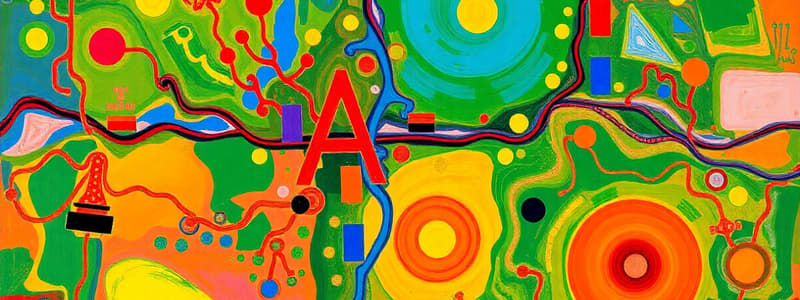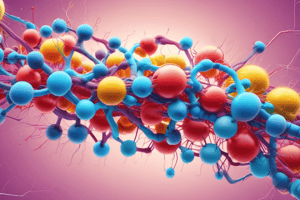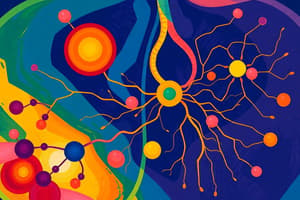Podcast
Questions and Answers
What are the three main steps of aerobic respiration?
What are the three main steps of aerobic respiration?
- Glycolysis, Krebs cycle, Lipolysis
- Glycolysis, TCA cycle, Electron Transport System (correct)
- Glycolysis, TCA cycle, Gluconeogenesis
- Glycolysis, Electron Transport System, Fermentation
Where is the Electron Transport System located in eukaryotic cells?
Where is the Electron Transport System located in eukaryotic cells?
- Cytoplasm
- Nucleus
- Cell membrane
- Inner membrane of the mitochondria (correct)
How many ATP are produced from one molecule of NADH during the Electron Transport System?
How many ATP are produced from one molecule of NADH during the Electron Transport System?
- 4 ATP
- 2 ATP
- 3 ATP (correct)
- 1 ATP
What is the final electron acceptor in the Electron Transport System?
What is the final electron acceptor in the Electron Transport System?
What contributes to the formation of the proton motive force (pmf)?
What contributes to the formation of the proton motive force (pmf)?
How many total ATP are produced from one molecule of glucose during aerobic respiration?
How many total ATP are produced from one molecule of glucose during aerobic respiration?
What is the sum of NADH and FADH2 produced by glycolysis and the TCA cycle?
What is the sum of NADH and FADH2 produced by glycolysis and the TCA cycle?
What is the role of ATP synthase in the Electron Transport System?
What is the role of ATP synthase in the Electron Transport System?
Why is aerobic respiration considered the most common catabolic strategy?
Why is aerobic respiration considered the most common catabolic strategy?
Which process occurs during glycolysis?
Which process occurs during glycolysis?
Aerobic respiration comprises only two steps: Glycolysis and the TCA cycle.
Aerobic respiration comprises only two steps: Glycolysis and the TCA cycle.
A total of 34 ATP can be produced during the Electron Transport System for every glucose molecule.
A total of 34 ATP can be produced during the Electron Transport System for every glucose molecule.
The final electron acceptor in the Electron Transport System is carbon dioxide.
The final electron acceptor in the Electron Transport System is carbon dioxide.
During glycolysis, a total of 2 ATP are generated.
During glycolysis, a total of 2 ATP are generated.
FADH2 can produce 3 ATP during the Electron Transport System.
FADH2 can produce 3 ATP during the Electron Transport System.
Proton motive force (pmf) is created by a concentration difference of H+ across the mitochondrial membranes.
Proton motive force (pmf) is created by a concentration difference of H+ across the mitochondrial membranes.
Glycolysis and the TCA cycle produce a combined total of 12 NADH and FADH2.
Glycolysis and the TCA cycle produce a combined total of 12 NADH and FADH2.
Aerobic respiration can occur without oxygen in all organisms.
Aerobic respiration can occur without oxygen in all organisms.
The TCA cycle does not contribute to the generation of ATP directly.
The TCA cycle does not contribute to the generation of ATP directly.
A complete aerobic respiration cycle produces 38 ATP from one glucose molecule.
A complete aerobic respiration cycle produces 38 ATP from one glucose molecule.
What is the primary purpose of cellular respiration?
What is the primary purpose of cellular respiration?
Which stage of cellular respiration occurs in the cytoplasm?
Which stage of cellular respiration occurs in the cytoplasm?
How many NADH molecules are produced during glycolysis?
How many NADH molecules are produced during glycolysis?
What is the main product of the Krebs Cycle for each glucose molecule?
What is the main product of the Krebs Cycle for each glucose molecule?
During which stage of cellular respiration is the most ATP produced?
During which stage of cellular respiration is the most ATP produced?
What type of process is glycolysis classified as?
What type of process is glycolysis classified as?
What is the function of NADH and FADH2 in cellular respiration?
What is the function of NADH and FADH2 in cellular respiration?
How many ATP molecules are produced from a single glucose molecule during cellular respiration?
How many ATP molecules are produced from a single glucose molecule during cellular respiration?
What occurs during fermentation in the absence of oxygen?
What occurs during fermentation in the absence of oxygen?
In which part of the cell does the Krebs Cycle occur?
In which part of the cell does the Krebs Cycle occur?
Flashcards are hidden until you start studying
Study Notes
Electron Transport System (ETS)
-
Location: Inner mitochondrial membrane (eukaryotes) or cell membrane (prokaryotes)
-
Function: Transfers electrons from NADH and FADH2 via a series of redox reactions, ultimately to oxygen (final electron acceptor).
-
Proton Motive Force (pmf): H+ ions are pumped across the inner mitochondrial membrane, creating a concentration gradient. This potential energy is called pmf.
-
ATP Synthesis: pmf drives H+ ions back across the membrane through ATP synthase, producing ATP from ADP.
-
ATP Yield:
- Each NADH generates enough pmf to produce 3 ATP
- Each FADH2 generates enough pmf to produce 2 ATP
Aerobic Respiration Summary
- Total ATP Yield: 38 ATP (2 from glycolysis, 2 from TCA cycle, and 34 from ETS)
- Product: 6 CO2 molecules
- Oxygen Requirement: Oxygen serves as the final electron acceptor in the ETS.
- Prevalence: The most common catabolic strategy used by eukaryotes and many prokaryotes.
Aerobic Respiration: Electron Transport System (ETS)
- Location: Inner mitochondrial membrane (eukaryotes), cell membrane (prokaryotes)
- Function
- Transfers electrons from NADH and FADH2 through a series of redox reactions.
- Uses oxygen as the final electron acceptor.
- Pumps protons (H+) across the inner mitochondrial membrane, creating a proton motive force (pmf).
- Proton Motive Force (pmf):
- Concentration difference of H+ across the inner mitochondrial membrane.
- Potential energy that drives ATP synthesis.
- ATP Synthesis:
- Protons flow through ATP synthase back into the mitochondrial matrix.
- This flow powers the conversion of ADP to ATP.
- ATP Yield from ETS:
- Each NADH produces 3 ATP.
- Each FADH2 produces 2 ATP.
- With 10 NADH and 2 FADH2 from glycolysis and the TCA cycle, the ETS yields 34 ATP.
Aerobic Respiration: Summary
- Steps: Glycolysis, TCA Cycle, Electron Transport System.
- Total ATP Produced: 38 ATP (2 from glycolysis, 2 from TCA, 34 from ETS)
- Oxygen Requirement: Oxygen is the final electron acceptor in the ETS.
- Prevalence: Common catabolic strategy for eukaryotes and many prokaryotes.
Cellular Respiration
- Cellular respiration is a chemical reaction that converts glucose and oxygen into energy, carbon dioxide and water.
- Cells use this energy to produce ATP, or adenosine triphosphate, which is used to power many cellular processes.
- In the absence of oxygen, cells undergo fermentation. In animal cells, this produces lactic acid, and in yeast cells, it produces ethanol.
- Cellular respiration consists of three main stages: glycolysis, the Krebs cycle and the electron transport chain.
Glycolysis
- The first stage of cellular respiration, glycolysis, occurs in the cytoplasm of the cell.
- It involves the breakdown of a single glucose molecule into two pyruvate molecules.
- During glycolysis, two ATP molecules are invested, but four are produced, resulting in a net gain of two ATP molecules.
- Two NADH molecules are also produced, which are used in the electron transport chain.
- This stage can occur without oxygen, meaning it is an anaerobic process.
Krebs Cycle
- Also called the citric acid cycle, this stage takes place in the mitochondria.
- Pyruvate molecules produced in glycolysis are used to produce two ATP molecules per glucose molecule.
- It also produces six NADH molecules and two FADH2 molecules per glucose molecule.
- This is an aerobic process because it requires oxygen.
Electron Transport Chain
- The final stage of cellular respiration, the electron transport chain, occurs in the mitochondria.
- It uses electrons from NADH and FADH2 to pump hydrogen protons across the inner mitochondrial membrane.
- This generates ATP, which is the main source of energy produced by cellular respiration.
- This process results in approximately 34 ATP molecules per glucose molecules, the largest number of ATP produced in this cycle.
Energy Production Summary
- Each glucose molecule can produce approximately 38 ATP molecules.
- Cellular respiration is vital for animals, providing energy to power all bodily functions.
Studying That Suits You
Use AI to generate personalized quizzes and flashcards to suit your learning preferences.




